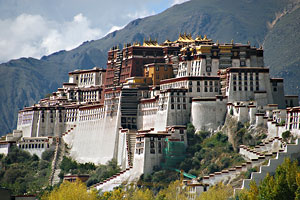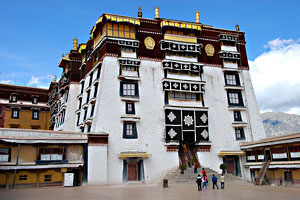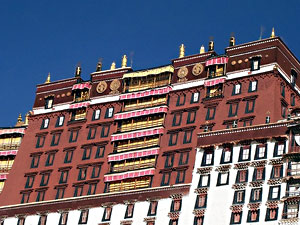|
|
Potala Palace, Lhasa |
|
Potala Palace
Potala Palace is located in the heart of Lhasa city.
Potala Palace has become a landmark for the city. Potala
Palace is located on the side of Marpo Ri hill, the Red
Mountain at an altitude of 3,700 m. The Potala Palace
was named after Mount Potala, the abode of Chenresig or
Avalokitesvara. The first palace was built by King
Songtsen Gampo in 637 in order to greet his bride
Princess Wen Cheng of the Tang Dynasty of China. This
extravagant palace was once used by Dalai Lamas as
|
 |
|
|
winter
retreat and is also known as the Winter Palace. But now it is
used as a museum to showcase precious articles of history,
culture and arts. You will also find the most sacred items of
Buddhist religion like amazing statues of Lord Buddha and many
religious paintings. In 1994, the palace was recognized as
world heritage site by UNESCO and named as the "New Seven
Wonders" by American media. Now, it is also on the list of
Chinese national key protected cultural relics. Being one of
the oldest structures in Tibet, Potala Palace has also become
the most visited monument in Tibet. You can visit the palace
between 9.30 AM to 1 PM and from 3 PM to 6 PM.
The construction of the palace was started
by King Songtsen Gumpa in the 7th century for his two newly
wed wives. The palace was used by the king as a retreat for
meditation till his death. The palace also suffered heavy loss
due to several wars and lightning strike and later
reconstructed by the order of 5th Dalai Lama in 1645. It gave
a new look to the structure as the palace was not only mended,
but was completely restructured, thus becoming a holy seat of
Dalai Lamas gaining the important political center. After the
7th Dalai Lama, who constructed a summer palace in Norbulingka,
Potala Palace was only used in winters. It stopped being abode
for Dalai Lamas after the 14th Dalai Lama was ousted from here
to Dharamshala in India due to a failed uprising against the
invading Chinese in 1959. Since then it is used as a State
museum of China and is now a famous tourist destination. The
construction of the present palace began in 1645 under the
fifth Dalai Lama, Lozang Gyatso. In 1648, the Potrang Karpo
known as White Palace was completed, and the Potala became the
winter palace of Dalai Lama from that time. The Potrang Marpo
or the Red Palace was added to the complex between 1690 and
1694.
Potala Palace generally comprises of two portions, the White
Palace which is the administrative block and the Red Palace -
a religious block. You will be entering the Palace from East
portal which will lead you to Deyang Shar courtyard. This is
the place where Dalai Lamas used to enjoy Tibetan Opera. To
the west of it is the White Palace. |
|
|
|
White Palace
The White Palace is the part of the Potala Palace that
makes up the living quarters of the Dalai Lama. The
first White Palace was built during the lifetime of the
fifth Dalai Lama in the 1650s then was extended to its
size today by the thirteenth Dalai Lama in the early
twentieth century. This palace was used for secular uses
and contained the living quarters of monks, offices, the
seminary and the printing house, on the fifth and sixth
floor. On the fourth floor, there is a longest hall of
the White Palace called the |
 |
|
|
Great East
Hall. It is a brilliantly decorated hall that was once used
for holding any big religious or political functions. A
central, yellow-painted courtyard known as a Deyangshar
separates the living quarters of the Lama and his monks with
the Red Palace. The yellow building at the side of the White
Palace in the courtyard between the main palaces houses giant
banners embroidered with holy symbols which hung across the
south face of the Potala during New Year festivals. From the
balcony of the White Palace, you will get a panoramic view of
Lhasa City. |
|
|
|
Red
Palace
In the Red Palace, you will find relics and antique of
7th century. The Red Palace is full of statues and
gorgeously carved stupas that will completely justify
your effort to come to Potala Palace. The Red Palace is
part of the Potala palace that is completely devoted to
religious study and Buddhist prayer. Here also you will
find a gigantic hall in the middle, the Greatest West
Hall, which is the largest hall in entire Potala Palace.
The walls of the halls are filled with portraits about
the life and works of fifth Dalai Lama. Apart from the
halls, you can also visit the other five chapels, The
Saint's Chapel, The |
 |
|
|
North Chapel,
The South Chapel, The East and The West Chapel. The North
Chapel is dedicated to Sakyamuni Buddha along with the fifth
Dalai Lama. Similarly, all other chapels are also dedicated to
some important personalities in the course of history. It
consists of an intricate layout of many different halls,
chapels and libraries on many different levels with a
multifaceted array of smaller galleries and winding passages:
The Great West Hall
The great West Hall is the main central hall of the Red
Palace, which consists of four great chapels that proclaim the
glory, and power of the builder of the Potala, the Fifth Dalai
Lama. The hall is illustrious for its fine murals reminiscent
of Persian miniatures, depicting events in the fifth Dalai
Lama's life. The famous scene of his visit to Emperor Shun Zhi
in Beijing is located on the east wall outside the entrance.
The numerous columns and pillars of the hall are wrapped with
a special cloth from Bhutan.
The Saint's Chapel
On the north side of the great west hall is this holiest
shrine of the Potala. The 19th century Tongzhi Emperor of
China wrote a large blue and gold inscription over the door.
It contains a small ancient jewel encrusted statue of
Avalokiteshvara and two of his attendants. On the floor below,
a low, dark passage leads into the Dharma Cave where Songsten
Gampo is believed to have studied Buddhism. In the holy cave
are images of Songsten Gampo, his wives, his chief minister
and Sambhota, the scholar who developed Tibetan writing in the
company of his many divinities.
The North Chapel
The North Chapel centres on a crowned Sakyamuni Buddha on the
left and the Fifth Dalai Lama on the right seated on splendid
gold thrones. Their equal height and shared aura entails an
equal status. On the far left of the chapel is the gold stupa.
This tomb belongs to the Eleventh Dalai Lama who died as a
child and has rows of benign Medicine Buddhas who were the
heavenly healers. On the right of the chapel are
Avalokiteshvara and his historical incarnations including
Songsten Gampo and the first four Dalai Lamas.
The South Chapel
The South Chapel centres on Padmasambhava, the 8th century
Indian magician and saint accompanied by his two wives. His
Tibetan wife, a gift from the King is by his left knee and his
other wife from his native land of Swat is by his right. On
his left, eight of his holy manifestations meditate with an
unturned gaze. On his right, eight furious manifestations
wield instruments of magic powers to subdue the demons of the
Bon faith.
The East Chapel
The East chapel is devoted to Tsong Khapa the founder of the
Gelug tradition. Lamas from Sakya Monastery who had briefly
ruled Tibet and formed their own tradition until converted by
Tsong Khapa surround his central figure. There are also some
other statues on display that are made of various different
materials and exhibit noble expressions.
The West Chapel
This chapel contains the five golden stupas. The massive
central stupa contains the mummified body of the Fifth Dalai
Lama. This stupa is built of sandalwood and is amazingly
coated in 3,727 kg of solid gold and studded with
semi-precious jewels. It is almost 50 feet high and rises to
three storeys. On the left is the funeral stupa for the
Twelfth Dalai Lama and on the right that of the Tenth Dalai
Lama.
The Galleries
The First Gallery is on the floor above the West chapel and
has a number of large windows that give light and ventilation
to the Great West Hall and its chapels below. The Second
Gallery provides access to the central pavilion which is used
for visitors to the palace for refreshments and to buy
souvenirs. The Third Gallery has a number of dark rooms
branching off it containing enormous collections of bronze
statues and miniature figures made of copper and gold worth a
fortune.
The Tomb of the Thirteenth Dalai Lama
The tomb of the 13th Dalai Lama is located west of the Great
West Hall. Built in 1933, this 14 metres high giant stupa
holds priceless jewels and one ton of solid gold. Devotional
offerings include elephant tusks from India, ceramic lions and
vases and a pagoda made from over 200,000 pearls. The
elaborated murals of stupa exhibit the traditional Tibetan
style and depict many events of the life of the Thirteenth
Dalai Lama during the early 20th century. |
|